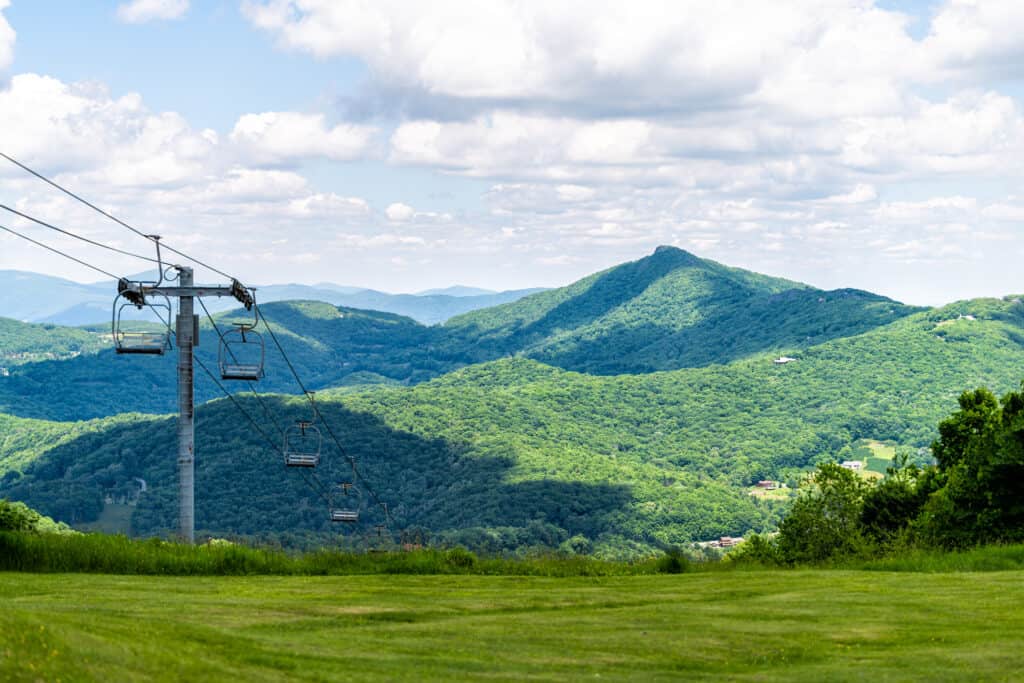
The Blue Ridge Mountains offer some of the most scenic getaway spots in all of Appalachia.
©iStock.com/krblokhin
Spanning 550 miles across the eastern United States, the Blue Ridge Mountains provide a beautiful and adventurous getaway for outdoor lovers all over the world. However, visitors to this region are often concerned about what types of snakes may be lurking along the mountains’ scenic trails.
While there are at least 20 species of snakes living in the Blue Ridge Mountains, only two of them are venomous. However, both are shy and rarely encountered by humans. These snakes, along with many other harmless species, are an integral part of the ecosystem and help the landscape to flourish and thrive. Let’s learn more about some of these reptilian residents by looking at 10 snakes in the Blue Ridge Mountains.

1. Timber Rattlesnake
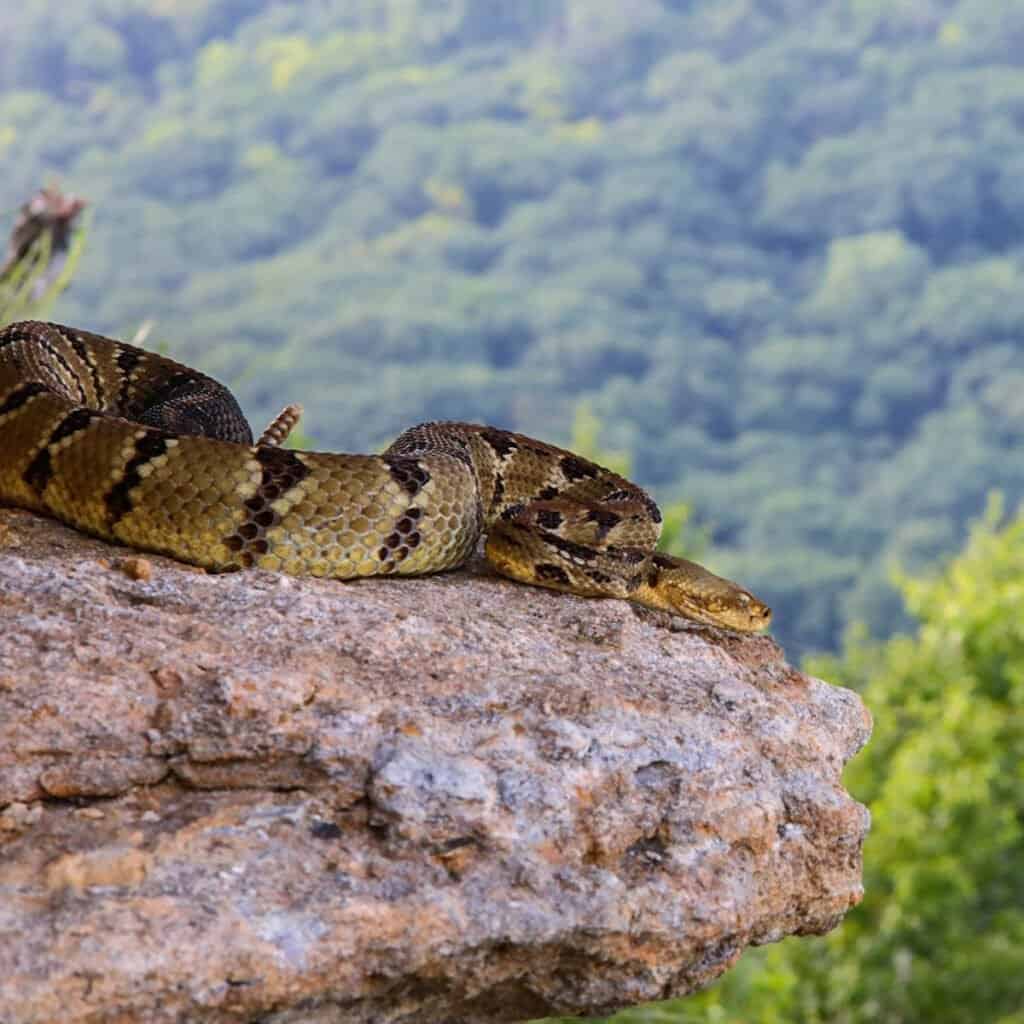
Timber Rattlesnakes are found in the Blue Ridge Mountains and are the most venomous snake in the U.S.
©bradenjalexander/Shutterstock.com
One of the larger snakes in the Blue Ridge Mountains is the Timber or Canebrake Rattlesnake. Timber rattlesnakes can grow up to 72 inches in length with thick, heavy bodies. Because of their large size, these rattlesnakes can inject a lot of venom when they bite. However, timber rattlesnakes are shy and reclusive, and only bite as a last resort. Most timber rattlesnakes will give you fair warning by rattling their tails loudly.
Timber rattlesnakes commonly live along the edges of forests and woodlands, rocky hillsides and outcroppings, and sometimes in fields. If you do happen to come across a timber rattlesnake, give the snake a wide berth and leave it alone.
2. Copperhead Snake
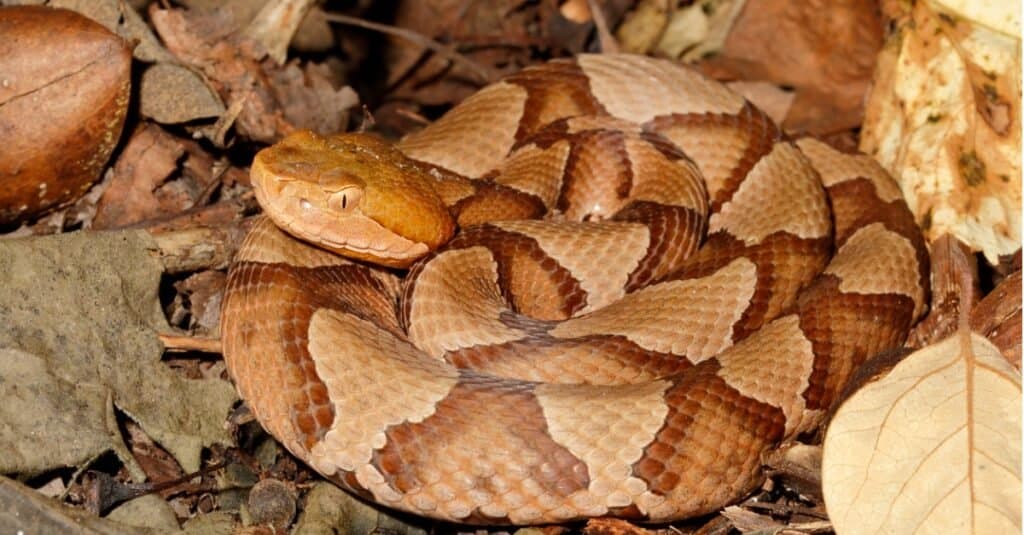
Copperhead snakes are one of only two venomous snakes in the Blue Ridge Mountains.
©iStock.com/David Kenny
The other venomous snake in the Blue Ridge Mountains is the Copperhead Snake. Copperhead snakes often live in rocky areas, forested regions, or fields, and are much more common in this region than timber rattlesnakes. Although they are venomous, their bites are rarely fatal. Copperhead snakes are relatively large snakes, measuring 36-48 inches long with copper-red heads and hourglass-shaped patterns on their backs and sides. They also have a yellow-tipped tail that they use lure prey closer before striking.
3. Northern Water Snake
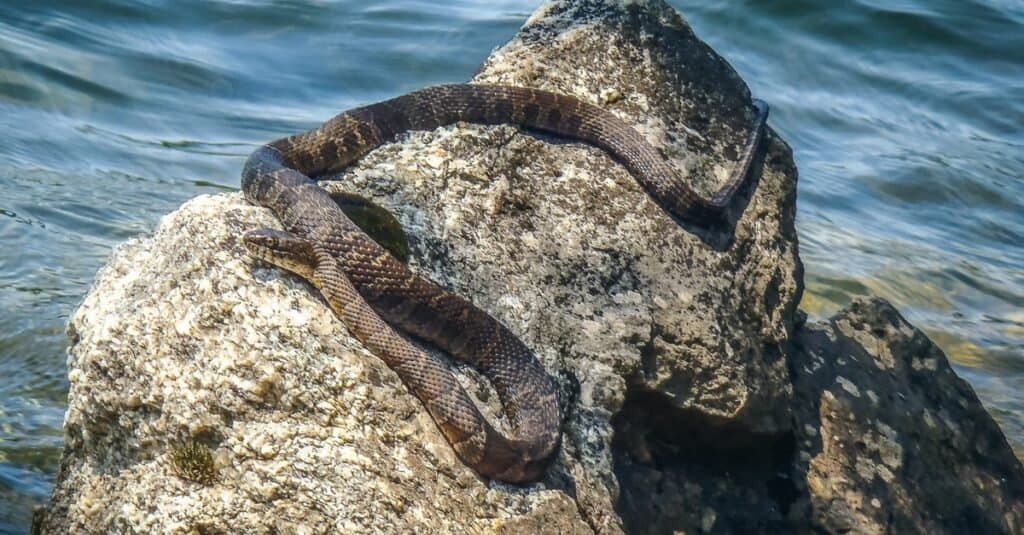
Northern water snakes are sometimes confused with the venomous northern copperhead. Copperheads, however, are rarely found in water.
©jmarino/Shutterstock.com
The Blue Ridge Mountains are home to another seemingly daunting snake, the Northern water snake. This snake, however, is not venomous, but it can bite. In fact, northern water snakes are quite temperamental and will repeatedly bite if they are threatened or agitated. Although they are not venomous, their saliva contains an anticoagulant, which can cause extra bleeding.
Northern water snakes live in lakes, streams, and wetlands along the Blue Ridge Mountains, feeding on frogs, fish, and crayfish. During the day, you may see these large snakes basking in the sun on rocks or logs. Northern water snakes grow 24-54 inches long with gray, brown, tan, reddish-brown, or brownish-black bodies patterned with dark splotches or bands.
4. Black Kingsnake
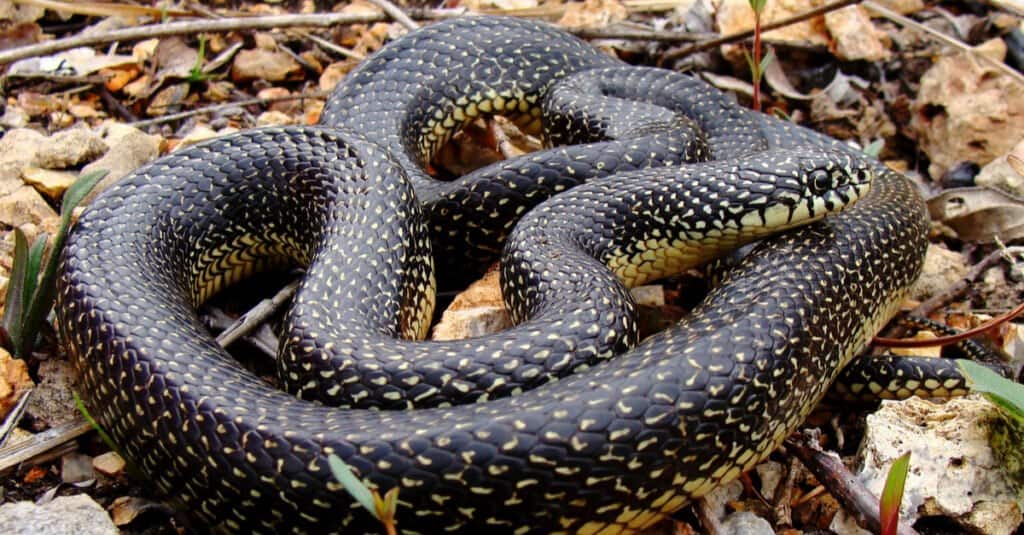
The toxins from venomous snakes do not bother kingsnakes, so they often hunt and eat their venomous relatives.
©Matt Jeppson/Shutterstock.com
Like their name, black kingsnakes have glossy black or dark brown bodies that grow 36-48 inches long. Their bellies are black and white, cream, or yellow, with mottled speckles and checkerboard patterns. Black kingsnakes are nonvenomous but can hunt and consume other venomous snakes. They often live along creeks, streams, and freshwater marshes, as well as in fields and hardwood forests. When threatened, black kingsnakes may vibrate their tails and release a foul-smelling musk.
5. Eastern Milk Snake
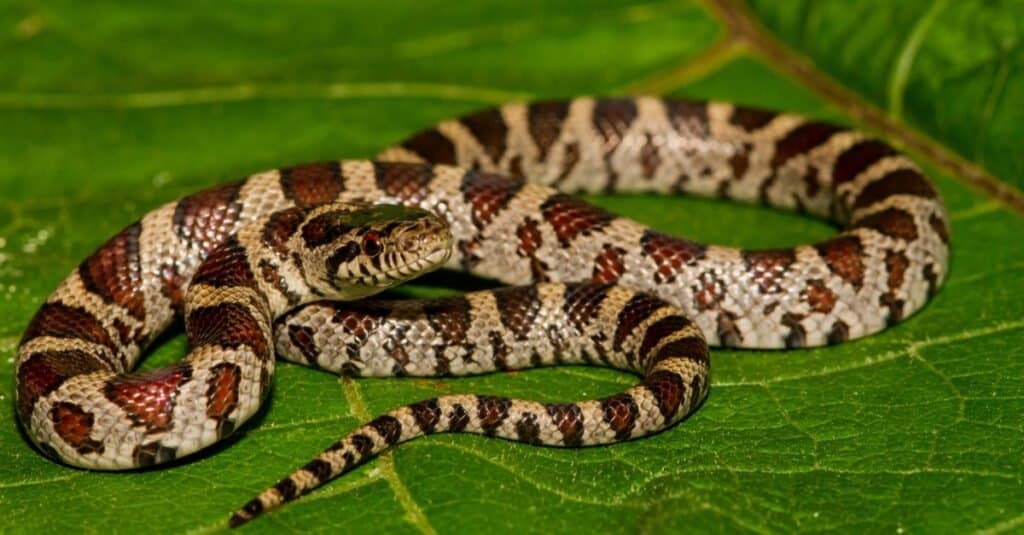
Eastern milk snakes are very beneficial animals, especially for farmers, as they hunt down small rodents often found on farm buildings and barns.
©Jay Ondreicka/Shutterstock.com
The colors and patterns of Eastern milk snakes serve as a defensive measure by mimicking venomous coral snakes so that predators will leave them alone. Fortunately, however, coral snakes do not live in the Blue Ridge Mountains. Eastern milk snakes, on the other hand, are nonvenomous and completely harmless to humans.
Measuring 24-36 inches long with gray, brown, or tan bodies, eastern milk snakes will have either blotches or banded patterns along their backs. Blotched milk snakes have reddish or reddish-brown blotches with black outlines. Banded milk snakes have red, yellow, and black bands running along the length of their bodies. The red and yellow bands are separated by black, which is a helpful way to know that this snake is not a venomous coral snake. In addition, eastern milk snakes have white or cream bellies with black checkerboard blotches.
6. Eastern Garter Snake
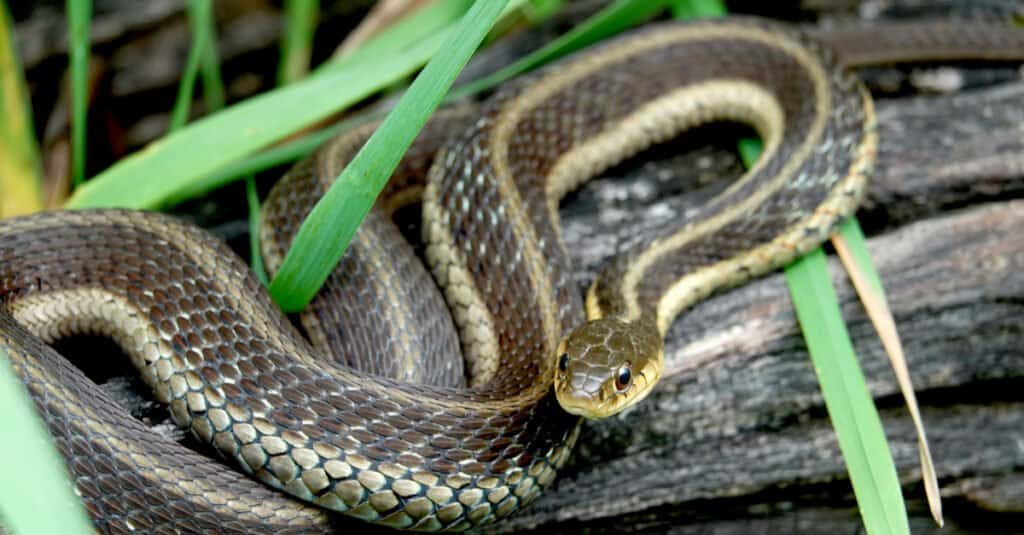
Garter snakes don’t have fangs and aren’t venomous. However, they do have a few rows of small teeth and can bite.
©Erik Agar/Shutterstock.com
The Eastern garter snake is very common in the Blue Ridge Mountains and lives in a variety of different habitats, from meadows and marshes to forests and even suburban backyards. These snakes are typically around 48 inches long with gray, olive-green, brown, black, or reddish colored bodies. Each color variation, however, has three long, light-colored stripes that run along the length of the snake’s slim body, like long “garters”. Eastern garter snakes are nonvenomous and harmless to humans. They eat insects, earthworms, fish, salamanders, and frogs.
7. Eastern Rat Snake
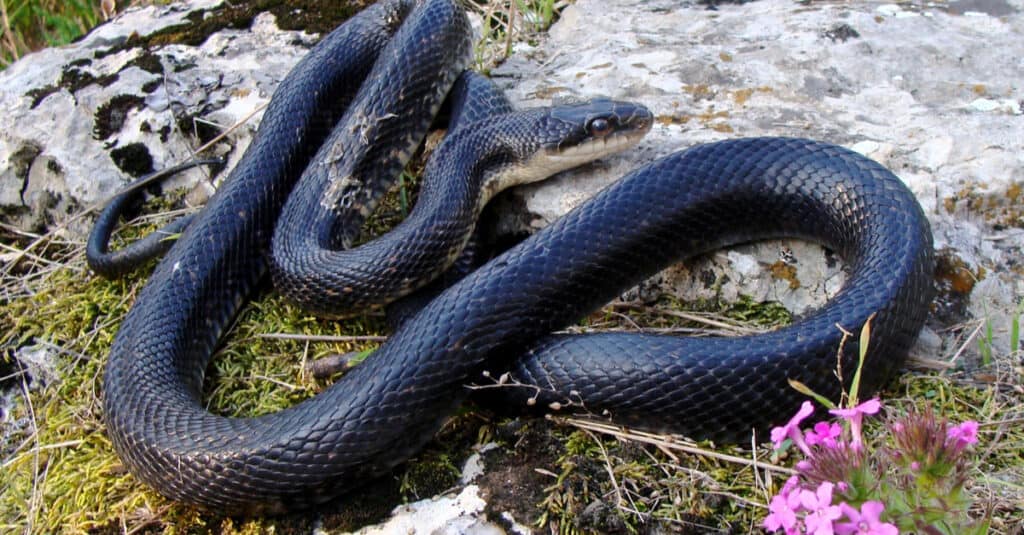
Reaching a length of up to 8 feet, black rat snakes are one of the longest snakes in North America.
©Matt Jeppson/Shutterstock.com
Another harmless snake in the Blue Ridge Mountains is the Eastern rat snake (or black rat snake). These snakes can be found in flat farmland, as well as in rocky or forested areas and along hillsides. Eastern rat snakes are large snakes that grow between 42-72 inches long. Their bodies are usually black or dark gray, with white or cream-colored chins, throats, and bellies. Eastern rat snakes eat a large variety of food, including frogs, rodents, young birds, and eggs. They are nonvenomous constrictors that can climb and swim with ease. When threatened, eastern rat snakes release a bad-smelling musk that has a poisonous taste.
8. Northern Black Racer
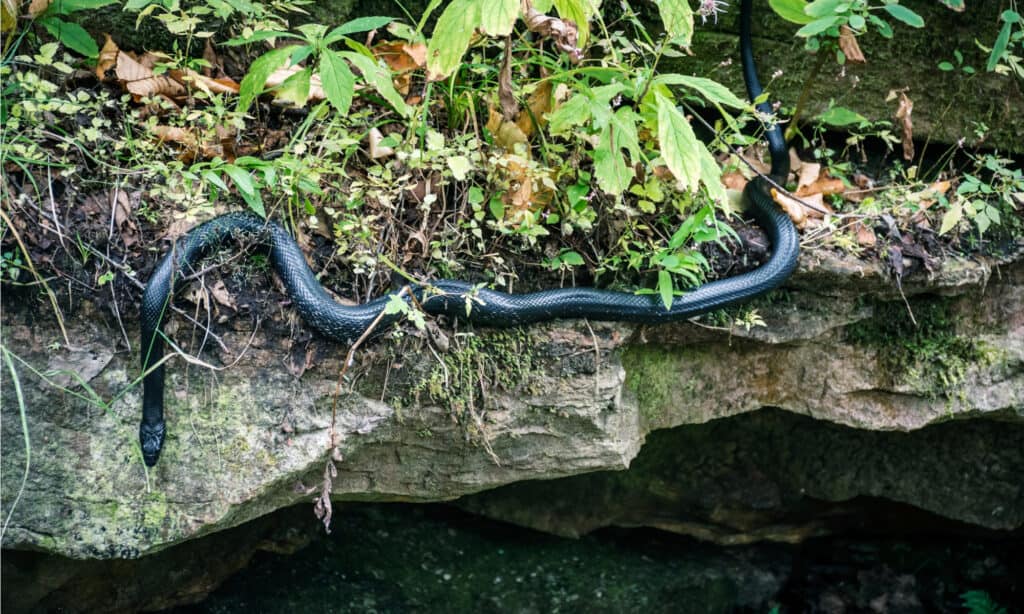
The Northern black racer has a solid black, cylindrical body with a bluish belly and white chin.
©Andrew F. Kazmierski/Shutterstock.com
With their long black bodies and creamy white chins, Northern black racers look very similar to Eastern rat snakes. However, these snakes have blue-gray bellies or cream/white ones. In addition, northern black racers have rounded bodies that are like an elongated cylinder, usually 33-65 inches long. These snakes prefer living in open forest areas, meadows, and fields.
Like their name, northern black racers are fast and active hunters, eating toads, frogs, insects, small mammals, and small birds. However, they are more commonly seen resting and basking in the sun. Northern black racers avoid humans whenever possible, but if threatened, they may vibrate their tails, release a foul-smelling musk, or try to bite. However, these snakes are nonvenomous, and their bite is not very strong.
9. Eastern Hognose Snake
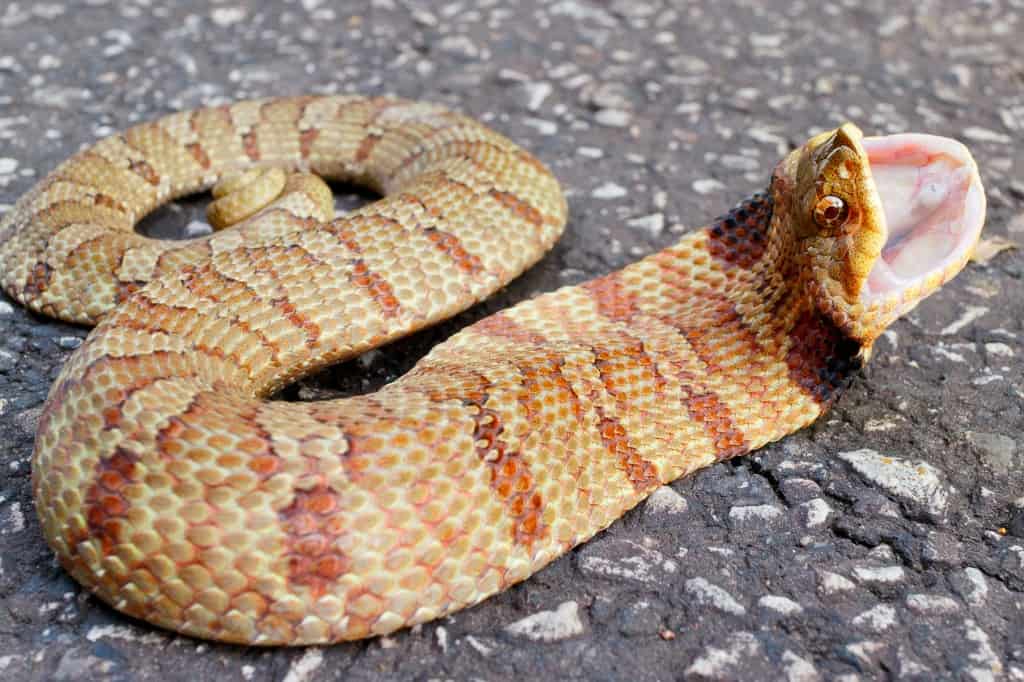
Hognose snakes are known for their extreme defensive tactics. Although these snakes live in the Blue Ridge Mountains, they are not commonly seen.
©iStock.com/Rex Lisman
A rather unique snake in the Blue Ridge Mountains is the Eastern hognose snake. However, these snakes are shy and avoid humans, so you likely will not see one. Averaging around 28 inches, eastern hognose snakes have stocky bodies and a very wide mouth that allows them to easily consume toads. These snakes may be black, brown, gray, green, orange, red, or even a combination of several colors. Some hognose snakes are solid in color, while others have bands or blotched patterns along their backs.
If it feels like it is in danger, an eastern hog-nosed snake will stretch and flatten out its neck like a cobra. It will also hiss loudly and feign a strike. In addition, it may even put on a dramatic show of “dying” before effectively “playing dead”.
10. Northern Ringneck Snake
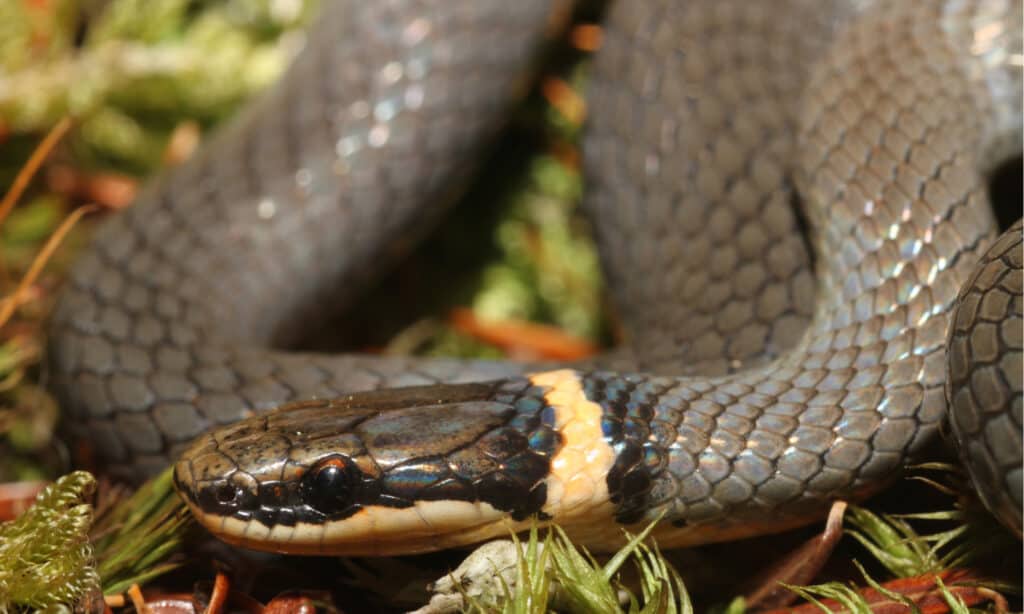
Close-up view of the head of a Northern Ringneck Snake. Ringneck Snakes will play dead when threatened.
©/Shutterstock.com
One of the smallest snakes in the Blue Ridge Mountains is the Northern ringneck snake. With small, slender bodies, these snakes only grow around 10-15 inches in length. Their bodies are solid gray or a bluish-black color, with small glossy scales. Like their name, however, there is a yellow or reddish “ring” pattern around their necks that matches the color of their bellies.
It is hard to say for sure just how many of these snakes live in the Blue Ridge Mountains, as they are extremely secretive and rarely seen. They are masters of hiding in woodlands, along fields, and even in suburban backyards.
Summary Of The 10 Snakes In The Blue Ridge Mountains
| # | Snake |
|---|---|
| 1 | Timber Rattlesnake |
| 2 | Copperhead Snake |
| 3 | Northern Water Snake |
| 4 | Black Kingsnake |
| 5 | Eastern Milk Snake |
| 6 | Eastern Garter Snake |
| 7 | Eastern Rat Snake |
| 8 | Northern Black Racer |
| 9 | Eastern Hognose Snake |
| 10 | Northern Ringneck Snake |
Other Animals From The Blue Ridge Mountains

It’s highly unlikely to encounter a black bear in the Blue Ridge mountains as they dwell in remote regions of the woods.
©Elizabeth Caron/Shutterstock.com
Aside from the aforementioned slithering reptiles, the Blue Ridge mountain range is home to scores of fauna from humble herbivores to persistent predators. Some of the most commonly found creatures in this region include the beaver, opossum, coyote, gray fox, white-tailed deer, and raccoons.
Black bears are also native to deeper, thicker stretches of forest in the Blue Ridge Mountains, but tend to stay away from areas inhabited by humans. They are considered beloved icons of the Southern Appalachian Mountains and are the most common single bear species. Also known as the American bear, this animal consists of only one species but has 16 subspecies.
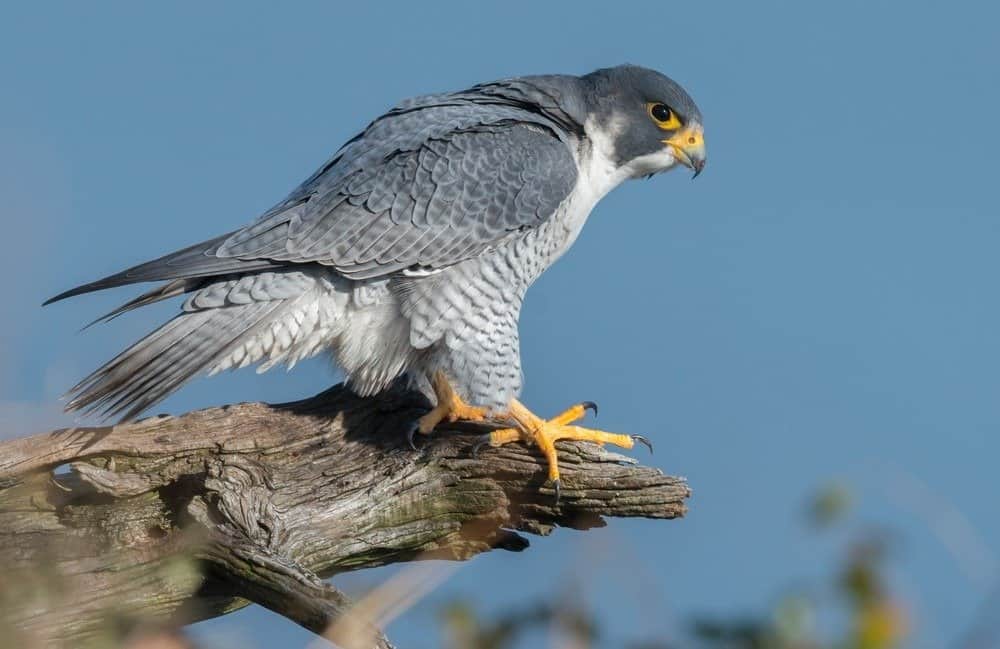
Peregrine Falcon sitting on branch
©Harry Collins Photography/Shutterstock.com
The peregrine falcon can be found in he Blue Ridge Mountains every spring when it returns to this area, when nesting occurs, beginning in March to early June. Still listed as an endangered species in North Carolina, this bird of prey can get one of the fastest airspeeds at up 240 miles per hour. This falcon is also a territorial bird and while not dangerous to humans, if challenged, they will use their razor-sharp talons to
The photo featured at the top of this post is © digidreamgrafix/Shutterstock.com
Discover the "Monster" Snake 5X Bigger than an Anaconda
Every day A-Z Animals sends out some of the most incredible facts in the world from our free newsletter. Want to discover the 10 most beautiful snakes in the world, a "snake island" where you're never more than 3 feet from danger, or a "monster" snake 5X larger than an anaconda? Then sign up right now and you'll start receiving our daily newsletter absolutely free.
Thank you for reading! Have some feedback for us? Contact the AZ Animals editorial team.







